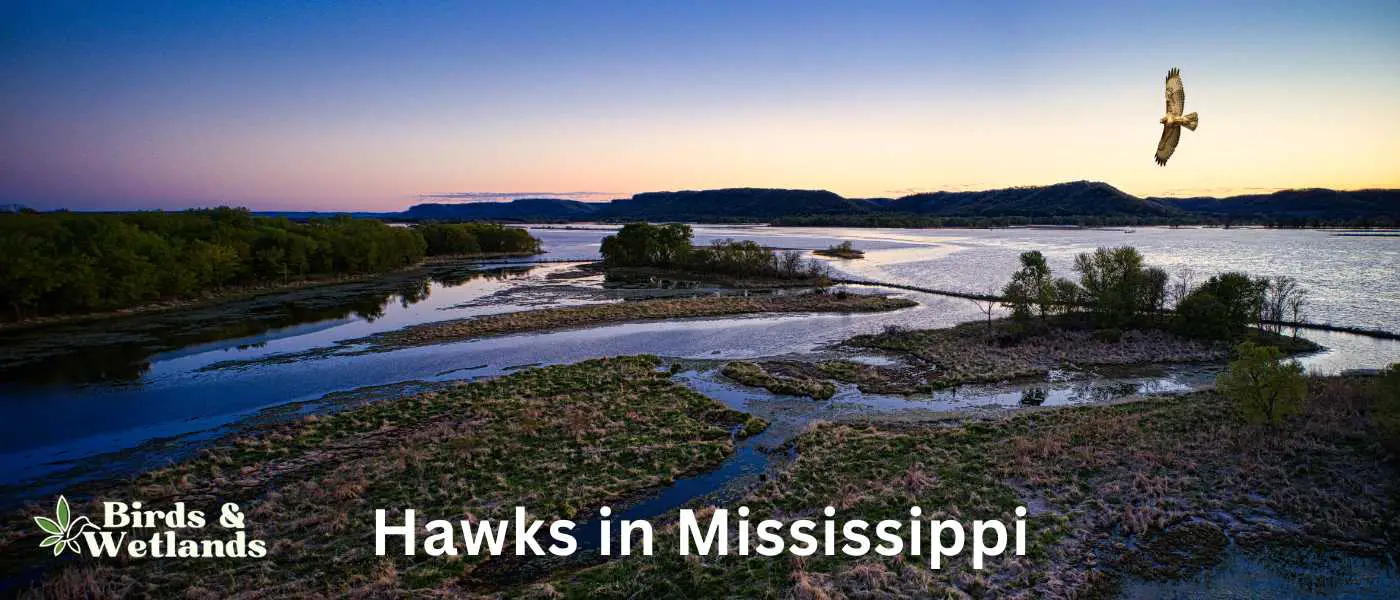Mississippi, with its vast wetlands, lush forests, and expansive river system, is a haven for a myriad of wildlife, including several species of hawks.
The sight of hawks soaring high above the Magnolia State’s landscapes is nothing short of awe-inspiring, capturing the imaginations of bird enthusiasts and nature lovers alike. Join us as we take a journey into the fascinating world of Mississippi’s hawks, each species a testament to the state’s vibrant biodiversity.
Types of Hawk in Mississippi
Red-tailed Hawks: Known for their brick-red tails, these hawks are a common sight around the open fields and roadside trees of DeSoto National Forest. Like many hawks, they fly south to Central America in one of the longest migratory routes of all raptors.
Cooper’s Hawks: Cooper’s Hawks can often be spotted navigating skillfully through the dense woods and tall trees of Natchez Trace Parkway, hunting smaller birds.
Red-shouldered Hawks: These woodland birds thrive in the wet, deciduous areas of the Delta National Forest, their distinctive, barred appearance and call marking their presence.
Broad-winged Hawks: During migration season, vast numbers of Broad-winged Hawks can be seen flying over Tishomingo State Park, a sight that leaves bird-watchers in awe.
Sharp-shinned Hawks: Known as agile fliers with dark feathers on, Sharp-shinned Hawks are year round residents in northern Mississippi and can often be spotted hunting typically prey on small birds and mammals in the mixed forests surrounding LeFleur’s Bluff State Park.
Northern Harriers: With their distinctive owlish face and long tail, Northern Harriers can be spotted gliding over open grasslands and marshes of the Noxubee National Wildlife Refuge.
Swainson’s Hawks: This long-distance migrant is known to make brief stops in Mississippi during their breeding season journey. Keep an eye out for these hawk species in the open fields of Holly Springs National Forest.
Mississippi Hawks Photo Guide
Red-tailed Hawk (Buteo jamaicensis)

The Red-tailed Hawk is a large bird of prey that is commonly found across North America. This species is part of the genus Buteo, which is often referred to as the “true hawks,” and includes more than two dozen species of raptors.
Red-tailed Hawks have a robust size, ranging from 18 to 26 inches in length and sporting a wingspan that can exceed 4 feet. They have a broad, rounded set of wings and a short, wide red tail. This species is most easily recognized by its rich, rust-colored tail, which gives it its common name. However, juvenile hawks might not yet have this distinctive feature.
Their feathers are generally dark brown on their dorsal side (back) with a lighter, often speckled, ventral side (front). The intensity and pattern of their plumage can vary significantly based on their age and geographic location, as there are about 14 recognized subspecies of Red-tailed Hawks.
As for their diet, Red-tailed Hawks are carnivores and have a broad diet that includes rodents, ground rabbits, reptiles, and other birds. They are skilled hunters that typically sit on high perches and use their keen eyesight to spot potential prey. Once they have identified a target, they swoop down to capture it with their powerful talons.
Red-tailed Hawks mate for life and build nests high off the ground, often in tall trees or on cliff edges. Their nests are made of sticks and can be quite large. They typically lay 1-3 eggs per year, which are incubated by both parents.
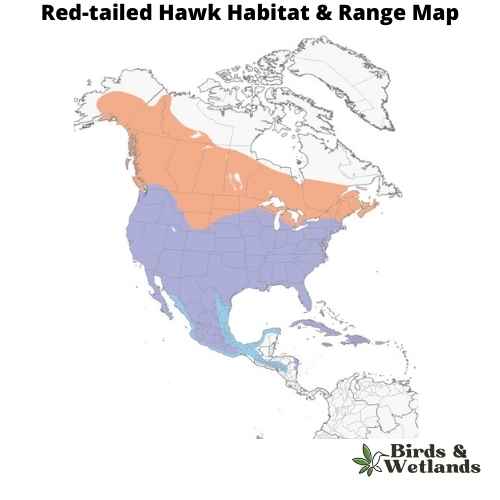
Red-tailed Hawk Sound
Cooper’s Hawk (Accipiter cooperii)

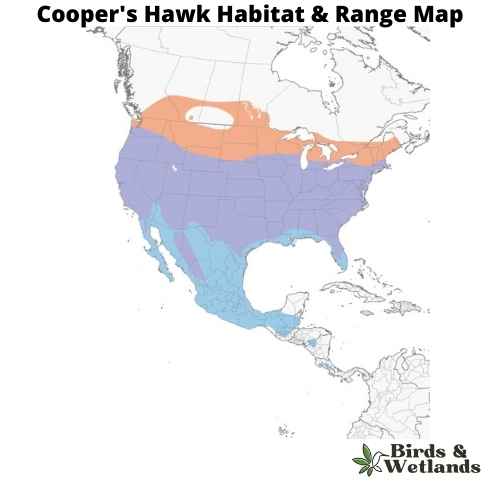
Listen:
The Cooper’s Hawk is a medium-sized bird of prey native to North America. Known for its agility and speed, it is part of the Accipitridae hawk species, which also includes other hawks, eagles, and kites.
Cooper’s Hawks are typically about 14 to 20 inches in length, with a wingspan ranging from 27 to 36 inches. They are known for their distinctive long, rounded tails and short, rounded wings. They have a steely blue gray top, with rusty bars on their underparts and thick, dark bands on their tails.
The Cooper’s Hawk is a skilled predator, primarily hunting birds and small mammals. They are adept at hunting in both dense forests and open areas, often catching prey mid-air in high-speed pursuits. They have also been known to visit the backyard bird feeder, not for the seed, but to prey on the smaller birds that gather there.
Cooper’s Hawks often build nests in dense tree canopies where they are well concealed. The female usually lays 3 to 5 eggs, and both parents share incubation duties. The young hawks fledge after about a month but will stay close to the nest, relying on their parents for food as they learn to hunt.
Red-shouldered Hawk (Buteo lineatus)

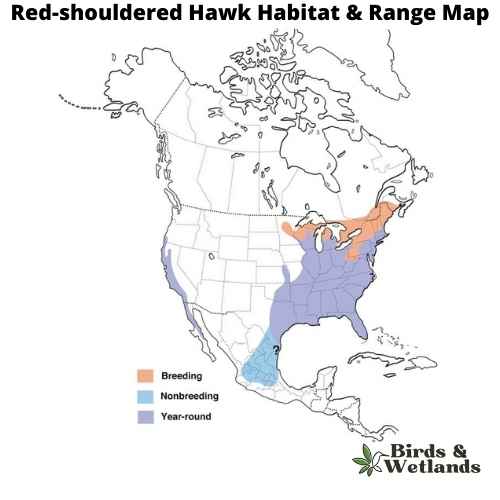
Listen:
The red-shouldered hawk are medium sized birds of prey, part of the buteo hawks family. It can be distinguished from other hawks by its reddish iris and pale legs.
The adult has rusty red upperparts, white underparts, a black chin and throat, and a reddish brown stripe over each eye, reddish brown heads and a strongly banded tail. The tail is reddish brown with two paler bands across it and they have white checkered wings. Juveniles are brown with dark barring and have pale fringes on the feathers of their wings.
Red-shouldered hawks nest in trees, though they also inhabit manmade structures including barns, bridges, and buildings. They prefer wooded areas with an open canopy but will use other places as well for nesting such as shrubs and hedges if needed.
The red-shouldered hawk’s diet – they eat small mammals such as ground squirrels, rabbits, voles, mice and rats. They also eat birds such as quail, pigeons and doves; reptiles including snakes; amphibians; fish; crustaceans; insects; and carrion (dead animals).
Broad-winged Hawk (Buteo platypterus)

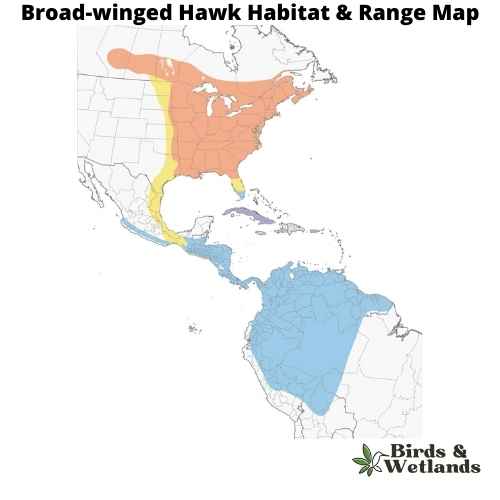
Broad-winged Hawk Sound
The Broad-winged Hawk holds a commanding presence as one of the largest hawks in the world, known for its broad wings. Its formidable size is a testament to its prowess as a bird of prey, effortlessly navigating the open skies in search of food.
Their distinctive appearance sets them apart. The adults exhibit a striking black and white pattern, complemented by a rusty breast and buff underparts and brown wings. In contrast, juveniles are adorned with a brown plumage, marked by pale edges on their feathers, adding to their distinctive youthful charm.
These hawks are most commonly found in open areas, such as farmlands or grasslands interspersed with scattered trees, which provide optimal conditions for when hawks hunt.
When it comes to their diet, Broad-winged Hawks feed on small rodents like mice, rats, squirrels, rabbits, and voles. Broad winged hawks breed during the spring and summer months then migrate to central and south America.
Sharp-shinned Hawk (Accipiter striatus)

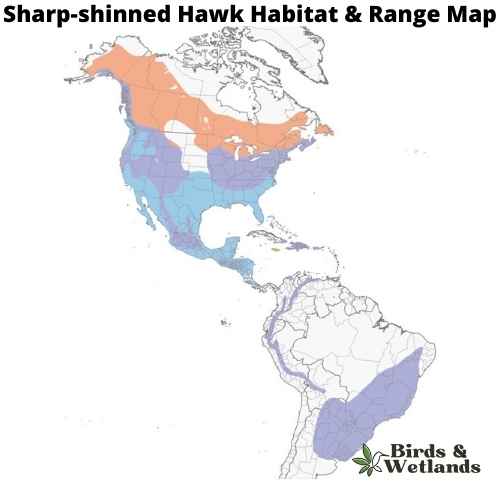
Listen:
The adult bird is brown on top and white underneath, with a dark brown band across its chest. It has short, rounded wings and a long tail that makes it look larger than it actually is. Adult sharp shinned hawks have black eyes, which are surrounded by white feathers. The female Sharp-shinned Hawk is browner than the male, who has darker brown markings on his back.
Sharp-shinned Hawks prefer open country for their habitat, including fields and meadows where they can hunt for mice and other small animals. They can be found throughout the United States but are most common in the east.
Sharp-shinned Hawks eat mostly small birds, such as sparrows and warblers, as well as small mammals such as mice and gophers. They catch prey by surprise using their incredible speed and agility, diving out of the sky at speeds up to 200 mph.
Sharp-shinned Hawks have an unusual hunting style for hawks—they prefer to catch their prey from perches above trees or telephone wires, rather than swooping down from above like most other hawks do and can often be seen hunting near bird feeders.
Northern Harrier (Circus hudsonius)

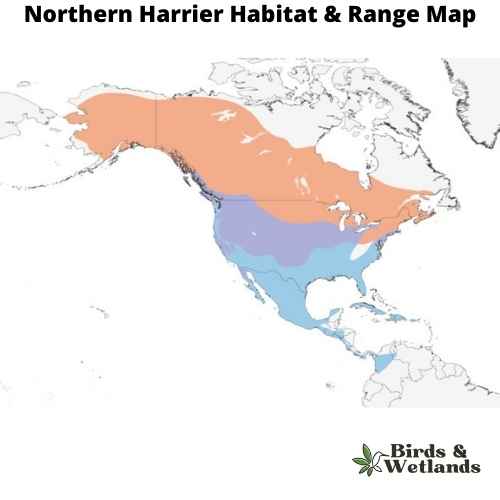
Listen:
The Northern Harrier is a medium-sized, slender hawk.
Adult birds are gray above, with pale bars on the wing feathers and white markings on the underwings and a white rump patch. The breast is barred with black and white, and the belly is streaked with brown.
They prefer open areas, such as grasslands and marshes, but can be found in almost any open habitat except dense woods.
Northern Harriers are opportunistic hunters that feed on small mammals such as mice, voles and rabbits as well as birds including quail, grouse and ducks. They hunt by flying low over open spaces such as fields or marshes.
Northern harrier nests on the ground in lowlands or hillsides near water bodies. It lays two to four eggs which hatch after 24 days of incubation by both parents. The chicks fledge after 30 days of hatching and remain dependent on their parents for another three weeks during which they learn how to fly.
Swainson’s Hawk (Buteo swainsoni)
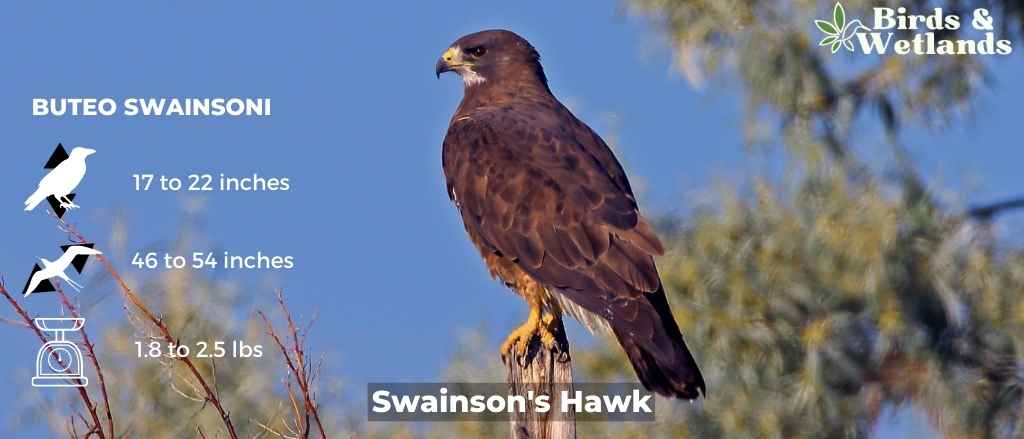
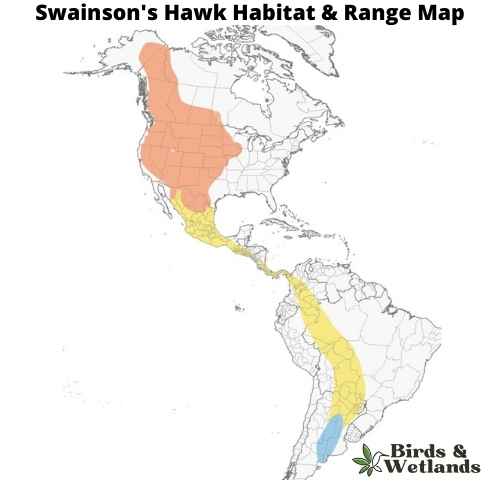
Listen: Swainson’s Hawk
Swainson’s Hawk is a medium-sized hawk that is found in North America and South America, Scientific Name: Buteo swainsoni.
The bird has a blue-gray plumage with a dark brown back, wings, and tail. It also has a white chest and belly. The beak and feet are black, but the eyes are yellow. They are often confused with Cooper’s Hawk because of similar coloring, but Swainson’s Hawks have wider tails and longer wings than their cousin species.
These birds eat small rodents such as gophers and mice. They also eat insects like grasshoppers and crickets during the summer months when they’re plentiful. They sometimes steal prey from other birds of prey such as Northern Harriers who hunt the same prey.
Swainson’s Hawks build nests on rocky cliffs near water sources where they can find food easily. They lay three to five eggs that hatch after about two months into fluffy brown baby hawks who leave the nest after about three weeks (or when they’re big enough).
Where to Spot Hawks in Mississippi
Noxubee National Wildlife Refuge
A habitat for Red-shouldered Hawks and Cooper’s Hawks, this refuge south of Starkville offers marshes, forests, and open waters ideal for hawk watching.
Delta National Forest
Located near Rolling Fork, this is the only bottomland hardwood forest in the National Forest system and provides the perfect habitat for a variety of hawks.
St. Catherine Creek National Wildlife Refuge
Near Natchez, this wildlife refuge is home to Red-tailed Hawks, Broad-winged Hawks, and other raptor species.
Gulf Islands National Seashore
On the coast, this national seashore offers the opportunity to see birds of prey, including hawks and other small mammals, against a stunning backdrop.
Desoto National Forest
Spanning multiple counties, the diverse habitat in this forest attracts many species of hawks including the Northern Harrier and Sharp-shinned Hawk.
| Neighbouring State | Best Hawk Spotting Site |
|---|---|
| Alabama Hawks | Monte Sano State Park |
| Arkansas Hawks | Mount Magazine State Park |
| Louisiana Hawks | Grand Isle State Park |
| Tennessee Hawks | Radnor Lake State Park |
Keep in mind that spotting hawks can be seasonal and usually requires patience and an understanding of their habits. Always show respect for nature and wildlife when bird watching.

